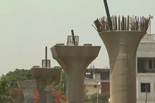India holds second round of vote
Largest phase of election begins amid attacks by suspected Maoist fighters.

Crucial phase
The army has been put on alert across the 13 states where voting is being held.
The election began on April 16 and will continue for a month, with results expected on May 16.
| In depth | |||||
 Features and analyses on India’s general election
| |||||
|
With more than 700 million eligible voters, India normally holds staggered elections for logistical and security reasons.
The second round is crucial for both the incumbent Congress party and the Bharatiya Janata Party (BJP).
Voters in the states of Andhra Pradesh and Orissa will also choose state assembly candidates.
Although large cities such as Bengaluru, formerly known as Bangalore, and Pune go to the polls during the second round, urban residents comprise only 22 per cent of the electorate.
But more people from within the urban voter base are expected to vote in this election compared to the previous one, largely due to a “get out and vote” campaign by the major parties.
“Traditionally the urban voting percentage was between 40 per cent and 45 per cent. This time there have been a lot of campaigns urging people to cast their votes,” Trilochan Sastry, from the Association for Democratic Reforms, told Al Jazeera.
“Even if the number goes to 50 per cent, it will be significant.”
Train attacked
The day before the second round vote, about 200 Maoist fighters stopped a train and held the passengers hostage for several hours in the eastern state of Jharkhand.
| The second round |
|
The second round of voting takes place in Andhra Pradesh (20 seats), Assam (11), Bihar (13), Goa (2), Jammu and Kashmir (1), Karnataka (17), Madhya Pradesh (13), Maharashtra (25), Manipur (1), Orissa (11), Tripura (2), Uttar Pradesh (17) and Jharkhand (8). The second phase covers the highest number of seats in the 545-member Lok Sabha, or lower house of parliament. Farmers and agricultural workers constitute about 71 per cent of the people voting in the second round. One out of every three agricultural labourers in the country could be casting his or her vote today. Polling has already been completed in 124 seats in the first phase on April 16. The remaining phases will be held on April 30 and May 7 and 13. |
All the passengers were released unharmed and there was no confrontation with security forces.
The hijacking on Wednesday, which took place in a Maoist stronghold about 900km east of New Delhi, was one of a series of attacks that included an explosion at another railway station, a blast at a government office, and the killing of a truck driver in the neighbouring state of Bihar.
The fighters have called on the public to boycott the national election and a pamphlet left at the attacked government office described the vote as “a fake exercise”.
“Strengthen revolutionary forces. You will pay with your lives if you participate in these elections,” it read.
More than three dozen attacks blamed on Maoist fighters occurred in the first phase of voting last week, leaving at least 17 people dead, including police, soldiers, polling officials and civilians.
Three election officials were kidnapped.
‘Internal security threat’
Manmohan Singh, India’s prime minister, has described attacks by Maoist fighters as India’s biggest internal security threat.
About 500 civilians and police were killed last year in violence linked to the Maoists.
The fighters, referred to as Naxalites, say they are inspired by Mao Zedong, the late Chinese communist leader.
They have been fighting for more than three decades in several Indian states, demanding land and jobs for agricultural labourers and the poor.
They usually do not speak to the media and instead communicate through pamphlets or statements sent to newspaper offices.

